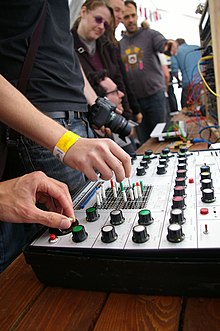Synthi-A
The Synthi-A is a monophonic analog synthesizer that was introduced in 1971 by Electronic Music Studios (EMS), London. It is essentially a VCS 3 synthesizer.
In contrast to this, the Synthi-A was built into a plastic briefcase instead of the L-shaped wooden case. This made the device even more compact and easier and safer to transport. On live and studio photos from the 1970s, Synthi-A and Synthi-AKS (see below) can be seen almost exclusively, which suggests that they are widely used. Since the Synthi-A is almost always referred to as “VCS 3” on albums or in captions, its name is hardly known.
Synthi-AKS
The Synthi-A was also available as a 'KS' version. This contained a keyboard and a sequencer in the case lid . However, both are not comparable with today's devices and were quite rudimentary even by the standards of the time.
The keyboard comprised only a few tones and consisted of a ladder surface on which blue and black foil indicated the "keys". The conductor surface reacted to contact and generated an electrical signal that could control the sequencer and synthesizer. So the keyboard had no mechanical keys, and the size of the circuit board fields was also not standard, which limited the use of the keyboard. Sufficient control of the sequencer, however, was quite possible.
EMS shortly thereafter introduced a higher quality mechanical external keyboard; In addition, both models could be used with other keyboards via the control voltage input. Today EMS even offers MIDI converters, so that Synthi-A have limited MIDI capabilities and can be controlled by modern synthesizers and PCs with studio software.
The sequencer only allowed "real-time recordings" of a melody played on the keyboard and this only with a limited time frame: For this purpose, the voltage values supplied by the keyboard were measured and saved at discrete times; the sampling frequency could be regulated continuously and had to be well above the maximum number of tones per time interval for rhythmically accurate reproduction. A total of 256 memory locations were available, so that the maximum recording time was based on the sampling frequency. Since the playback speed could also be continuously regulated, it made sense to play fast melodies slowly with a lower sampling frequency in order to ensure playful precision.
Although the Synthi-AKS was a groundbreaking technical innovation at the time and its performance compared to the space required is hardly matched by any other synthesizer of the analog era, from today's point of view, an ordinary Synthi-A is much more effective if via the control voltage inputs and a MIDI converter modern keyboards, sequencers and PCs can be connected. This allows much more comfortable editing, more flexible use, unlimited sequences and, above all, synchronization with other sequencers or a production played with a click.
A prominent example of the characteristic throbbing of the Synthi-AKS is the song On the Run by the British rock group Pink Floyd on their album The Dark Side of the Moon (1973), in which several Synthi-AKS were linked together. Some of these can be seen in the documentation Pink Floyd: Live at Pompeii , but referred to as "VCS 3" on the album.
